Training your calves is a essential part of building and trimming your legs. Whether you are a workout enthusiast or starting your first training plan, the exercises below will help you meet your fitness goals.
smith toe raise
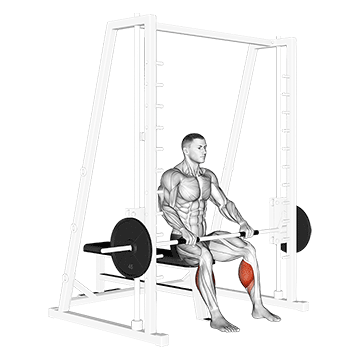
1. Start by setting up the Smith machine. Place the bar at a height that is just below your shoulders. Load the bar with the desired weight.
2. Stand under the bar, positioning it across the back of your shoulders. Your feet should be shoulder-width apart.
3. Reach up and grasp the bar with a wide, overhand grip. Unrack the bar by straightening your torso and legs. Step forward to unhook the bar from the safety pegs.
4. Position your feet so that your heels are on the floor and your toes are on a raised surface such as a weight plate or a wooden block. This is your starting position.
5. Slowly lower your heels towards the ground as far as you can. You should feel a stretch in your calf muscles.
6. Push through the balls of both feet to raise your body upward. Keep your abdominal muscles pulled in so that you move straight upward, not forward or backward.
7. Continue lifting your heels until you are standing on your toes. Hold this position for a moment to maximize the contraction in the calves.
8. Slowly lower yourself back to the starting position, inhaling as you do so.
9. Repeat for the recommended amount of repetitions.
10. After completing your set, carefully re-rack the bar on the Smith machine.
Remember to perform this exercise in a slow and controlled manner, focusing on the muscle-mind connection. Avoid using too much weight, as it can lead to improper form and potential injury.
smith standing leg calf raise
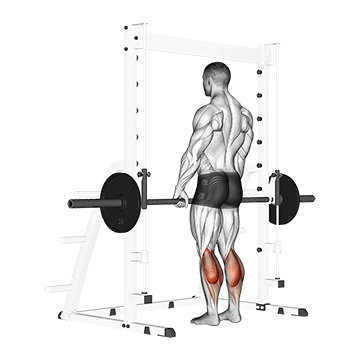
1. Start by positioning yourself under the Smith machine bar, which should be set to shoulder height. Stand with your feet shoulder-width apart.
2. Place the balls of both feet on a raised platform or weight plate. This allows for a greater range of motion during the exercise. Your heels should be free and not touching the platform.
3. Unrack the bar by twisting it, then lower your body down into a squat to position the bar across your shoulders. Stand back up to lift the bar off the rack.
4. Keep your core tight and your back straight. This is your starting position.
5. Slowly raise your heels as high as possible, pushing through the balls of both feet. Ensure the movement is controlled, do not use momentum to lift your body up. You should feel a contraction in your calves.
6. Hold the top position for a second, then slowly lower your heels back down below the platform, feeling a stretch in your calf muscles.
7. Repeat for the desired number of repetitions.
8. After completing your set, carefully re-rack the bar by squatting down again and twisting the bar back onto the rack.
Remember to adjust the weight to a suitable level that allows you to perform the exercise with correct form. It's important to keep the movement slow and controlled to effectively target the calf muscles.
smith seated one leg calf raise
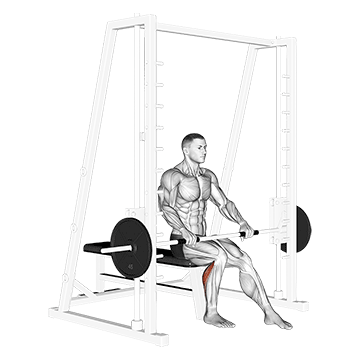
1. Start by setting up the Smith machine. Place the bar at a height that you can reach when seated on a flat bench.
2. Load the bar with the desired weight. Always remember to use a weight that you can handle comfortably to avoid injuries.
3. Sit on the bench and position yourself so that the bar rests on your thighs, just above your knees. Your feet should be flat on the floor.
4. Place your right foot on the edge of a raised platform or block, with your heel hanging off. Your left foot should be resting on your right knee.
5. Unrack the bar by pushing upwards and rotating it so the hooks are released. This is your starting position.
6. Slowly lower your right heel towards the floor as far as you can, feeling a stretch in your calf muscle.
7. Push through the ball of your foot to raise your heel as high as possible, contracting your calf muscle at the top of the movement.
8. Hold this position for a second, then slowly lower your heel back to the starting position.
9. Repeat for the desired number of reps, then switch legs and perform the same number of reps with your left leg.
10. After completing your set, carefully re-rack the bar by rotating it until the hooks catch onto the machine.
Remember to keep your movements slow and controlled throughout the exercise, focusing on the stretch and contraction of your calf muscles.
smith reverse calf raises
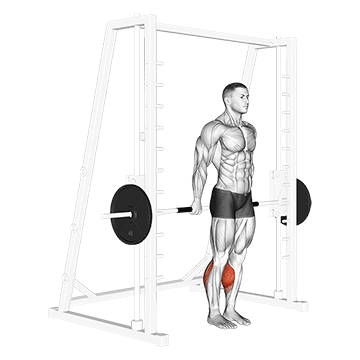
1. Start by setting up the Smith machine with the bar at a height that is just below your shoulder level. Load the bar with the desired weight.
2. Stand facing the Smith machine and position your shoulders under the bar. Your feet should be shoulder-width apart with your toes pointing forward.
3. Unrack the bar by straightening your torso and legs. Take a step back to ensure you have enough space to perform the exercise.
4. Place the balls of your feet on the edge of a raised platform or weight plate. Your heels should be hanging off the edge. This is your starting position.
5. Slowly lower your heels towards the ground as far as you can, feeling a stretch in your calves.
6. Pause for a moment at the bottom of the movement, then push through the balls of your feet to raise your body upwards. Your heels should be elevated above the level of the platform.
7. Squeeze your calves at the top of the movement and hold for a second.
8. Slowly lower your heels back to the starting position.
9. Repeat for the desired number of repetitions.
Remember to keep your core engaged and your back straight throughout the exercise. Adjust the weight as needed to suit your fitness level.
smith reverse calf raises

1. Start by setting up the Smith machine with the bar at a height that is just below your shoulder level. Load the bar with the desired weight.
2. Stand facing the Smith machine and position your shoulders under the bar. Your feet should be shoulder-width apart with your toes pointing forward.
3. Unrack the bar by straightening your torso and legs. Take a step back to ensure you have enough space to perform the exercise.
4. Place the balls of your feet on the edge of a raised platform or weight plate. Your heels should be hanging off the edge. This is your starting position.
5. Slowly lower your heels towards the ground as far as you can, feeling a stretch in your calves.
6. Pause for a moment at the bottom of the movement, then push through the balls of your feet to raise your body upwards. Your heels should be elevated above the level of the platform.
7. Squeeze your calves at the top of the movement and hold for a second.
8. Slowly lower your heels back to the starting position.
9. Repeat for the desired number of repetitions.
Remember to keep your core engaged and your back straight throughout the exercise. Adjust the weight as needed to suit your fitness level.
smith one leg floor calf raise
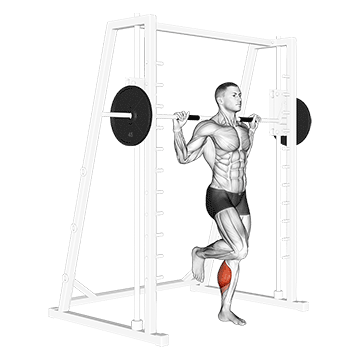
1. Start by setting up the Smith machine with a weight that you're comfortable with. Make sure the bar is at a height that you can easily reach when standing on one foot.
2. Stand under the bar and position it across your shoulders. Make sure it's not resting on your neck.
3. Disengage the bar from the rack and step forward slightly. Place a sturdy block or step under your foot if you need extra height for a deeper stretch.
4. Lift one foot off the ground, balancing on the ball of your other foot. This is your starting position.
5. Slowly lower your heel towards the ground, stretching your calf muscle. Make sure to keep your core engaged and your back straight.
6. Push through the ball of your foot to raise your body upwards. Your calf should be contracting at this point.
7. Pause at the top of the movement for a second, then slowly lower your heel back down to the starting position.
8. Repeat this movement for your desired number of reps, then switch to the other leg.
9. Remember to breathe throughout the exercise. Inhale as you lower your heel, and exhale as you push up.
10. Once you've completed your sets, carefully re-rack the bar on the Smith machine.
Remember, it's important to use a weight that's challenging but still allows you to perform the exercise with proper form. If you're new to this exercise, start with a lighter weight to get a feel for the movement.
No tags for this post.
